If you own a horse, you’ve probably discovered that when you ask different people what is the best hay to feed your horse, you never get a simple, standard reply. There are so many various opinions that people have about what to feed their horse, when their horse should be fed, how much they need and how different types of feed can affect their horse’s behavior and performance. You may have already tried to do some research on the best hay to feed your horse and most likely the more you’ve read, the more confused you become!
One thing we do know is that every horse has different nutritional requirements, since the age of the horse, the activity level, breed and size all play important roles in deciding which hay best suites your horse’s needs. Some horses may require higher protein and more energy, while others may need hay that is lower in protein and is not as rich. For example, a retired senior horse that is turned out in pasture is not going to have the same nutritional requirements as a high-level performance horse during show season. So here is a consolidated overview of some of the differences between hays to help you decide which is the best hay to feed your horse.
Nervous Horse? – It could be a nutritional deficiency
Different Types of Hay
There are quite a few different types of hay that people feed to horses, but hay generally falls into one of two categories – legumes and grasses. Alfalfa hay, sometimes called lucerne hay, is the most popular legume hay fed to horses in the U.S., while timothy and orchard are popular grass hay choices. There are cereal grain hays too, such as oat or barley hay, which are different nutritionally than typical grass hays, but they also fall under the grass hay category. Of course, when trying to select the best hay to feed your horse, geography will play a big part in your selection. For example, alfalfa, timothy and orchard grass hays are popular in Kentucky, while coastal Bermuda grass hay is popular in Southern U.S. Here’s a chart that shows some of the common hays that are fed to horses.
The nutritional profiles of different types of hay can vary considerably, especially when measuring fiber, protein content, digestible energy and mineral composition. To get started, here are some common terms used when evaluating hay:
Moisture: Ideally hay moisture should range between 10% – 17%. Hay that is under 10% may be brittle, dry and dusty. Hay that is over 18% has a high risk of developing mold, and hay over 25% can be a potential fire risk.
Crude Protein (CP): Protein levels in hay can vary widely, depending on the type of hay and when it was harvested. The younger the hay is when it was cut, the higher the protein level will be. Protein levels can range from 8% to 14% in grass hay, and 15% to 22% in legume (alfalfa) hay. In general, a growing horse needs between 12% and 18% protein in their diet for proper growth and development, while most mature horses will do fine on lower protein hay (10% – 12%). Horses that are in training are going to need more protein to support increased muscle development and replace nitrogen that is lost during exercise.
Digestible Energy (DE): Digestible Energy (DE) is measured in megacalories (Mcal) and most hays typically range from 0.76 to 0.94 Mcal/lb of DE. Daily DE requirements for an average size horse can range anywhere from 20 Mcals/lb (minimal maintenance) to 34.5 Mcals/lb (horses in heavy training).
Non-Structural Carbohydrates (NSC): This term is used to describe the sugar and starch content in hay. NSC’s are important, since these are the carbohydrates that are broken down and absorbed into the blood stream as glucose. Horses that are insulin resistant are typically put on low NSC “low-carb” diets.
Calcium (Ca) and Phosphorus (P): The balanced ratio between these two minerals, which varies among different types of hay, is very important because the two work closely together. Ideally, the calcium to phosphorus ratio in horses should be between 3:1 to 1:1. In other words, a horse needs at least as much calcium in his diet as phosphorus, never the reverse.
Does your horse need Joint Support?
So now that you know some of the basic terms used, here are some differences between alfalfa hay and grass hay that can help you decide which is the best hay to feed your horse.
ALFALFA HAY
Higher Protein Content
One of the biggest differences between alfalfa hay and grass hay is the protein content. On average, alfalfa hay has much higher levels of protein, ranging from 15% to 21% depending on when the alfalfa was cut. This is much higher than the protein levels of grass hay, which typically contains 10% or less protein. While most adult horses need somewhere around 10% to 12% protein in their diet, higher protein is important for young growing horses, working performance horses, and for lactating mares. If a horse is fed hay that contains more protein than they can utilize, the excess will be broken down and the waste will be eliminated in the urine as urea, which is then converted to ammonia. For horses kept in stalls, this could be a problem if the stalls are not properly cleaned and well ventilated.
Higher Energy Content / Lower In Fiber
The energy content is also different between alfalfa and grass hays. Alfalfa hay typically has more calories per pound than grass hay, so if you are feeding your horse alfalfa hay, he may need to consume less hay to maintain his body weight. This difference is related to the fiber content of the hay; alfalfa hay is lower in fiber, while grass hay is higher in fiber which allows the horse to eat more hay without putting on extra weight. For this reason, many people who want to reduce the calorie intake of their horse will feed grass hay instead of feeding alfalfa hay.
Higher Calcium Levels
Another major difference between alfalfa and grass hay is the mineral profile. Alfalfa hay typically has higher levels of calcium when compared to the amount of calcium in grass hay. The phosphorus content, however, usually is not that different between the two hays. And, of course, the mineral content in all hays will vary depending on the region in which it was grown as well as the soil conditions.
Alfalfa hay is very popular since it is readily available and is reasonably priced; it is the only forage that is sold in every state in the U.S. Not only is alfalfa easy to find, but horses also love the taste and almost always prefer the taste of alfalfa over grass hay. This is especially helpful for hard keepers since the sweet smell and green, leafy look of alfalfa hay is hard to resist.
Horses that have Equine Metabolic Syndrome (insulin resistance) and are prone to laminitis may be sensitive to alfalfa, most likely because alfalfa has more sugar and is higher in starch than most grass hays. So if your horse is insulin resistant and you are considering feeding him alfalfa hay, it would be best to discuss this option first with your vet.
Alfalfa hay analysis will vary depending on the time of year the alfalfa hay was harvested, the soil conditions in which it was grown, etc., but an average alfalfa hay analysis will be around this range:
Alfalfa Hay Analysis (average)
Crude Protein – 15.0% – 22.0%
Crude Fiber – 25.0%
Non Structural Carb (NSC) – 8.75% – 13.25%
DE, Mcal/Lb. – 1.06 – 1.32
Calcium – 1.28%
Phosphorus – 0.24%
Ca:P Ratio – 5.3:1
GRASS HAY
So now let’s turn our attention to some of the benefits of grass hay, and how it differs from alfalfa hay. Grass hay has:
- Lower Protein Levels
- Lower Energy Content
- Higher Fiber
- Lower Calcium Levels
Grass hay typically is quite a bit lower in protein than alfalfa hay; the energy content of grass hay is also generally lower than alfalfa hay. For many people who have horses, especially mature horses, non-working horses, or horses that are not used for breeding, grass hay is often preferred over alfalfa hay because of these lower protein and energy levels. Grass hay is also quite often a good choice for senior horses, as it’s easier on the kidneys due to its lower protein content and is also easier to chew and digest.
Grass hay is also a good hay choice for “easy keepers”, meaning horses that easily gain weight or struggle to keep their weight down, especially ponies or miniature horses. Because of the high fiber content, grass hay is a convenient solution for these easy keepers since it can satisfy the horse’s appetite, without adding extra calories and protein.
Grass hay typically has lower nutritional values than alfalfa hay, and is also lower in calcium, making it closer to a more desirable Ca:P ratio (between 3:1 to 1:1). Also, grass hay is often less dusty than alfalfa hay, so it a good choice for horses that have respiratory issues. And unlike alfalfa hay, grass hay is not subjected to the potential risk of blister beetles.
Here is quick look at some of the more popular grass hays and their typical profiles:
Timothy Hay
Timothy hay is high in fiber and generally is easy to digest. It tends to be more expensive than the other grass hays, but it is also higher in nutrients than other grass hays.
Timothy Hay Analysis (average)
Crude Protein – 6.0% – 10.0%
Crude Fiber – 30%
NSC – average of 12% (range 7% – 18%)
DE, Mcal/Lb. – 0.7 to 1.0
Calcium – 0.38%
Phosphorus – 0.17%
Ca:P Ratio – 2.2:1
Bermuda Grass Hay
Bermuda grass hay is usually less expensive than timothy or orchard hay. There are some concerns that lower quality bermuda grass hay may cause impaction in horses (discuss this with your vet).
Bermuda Grass Hay Analysis (average)
Crude Protein – 7.0% – 10.0%
Crude Fiber – 28%
NSC – average of 12% (range 7% – 18%)
DE, Mcal/Lb. – 0.7 – 1.0
Calcium – 0.43%
Phosphorus – 0.16%
Ca:P Ratio – 2.7:1
Orchard Grass Hay
Orchard grass hay is not as nutrient sensitive to the time of cutting as the other grass hays, and is also less expensive than timothy hay.
Orchard Grass Hay Analysis (average)
Crude Protein – 7.0% – 11.0%
Crude Fiber – 30%
NSC – average of 12% (range 7% – 18%)
DE, Mcal/Lb. – 0.7 – 1.0
Calcium – 0.34%
Phosphorus – 0.23%
Ca:P Ratio – 1.5:1
Oat Hay
Oat hay has thick tougher stalks that some horses will not eat. Oat hay tends to be higher in nitrates and also high in sugar (NSC), so this hay is not an option for insulin resistant horses.
Oat Hay Analysis (average)
Crude Protein – 8.0% – 10.0%
Crude Fiber – 28%
NSC – average of 22.1%
DE, Mcal/Lb – 0.82 – 0.96
Calcium – 0.29%
Phosphorus – 0.23%
Ca:P Ratio – 1.3:1
Here’s a comparison chart so you can see the differences between alfalfa hay, timothy (grass) hay and oat hay. As you can see, alfalfa hay has much higher protein levels than the other two hays, but is also lower in fiber than the other two. Oat hay, however, has much higher levels of non-structural carbohydrates (NSC) which are the levels of sugar and starch in the hay.
The chart below shows the average calcium levels, phosphorus levels, and calcium to phosphorus (Ca:P) ratio. Alfalfa hay, as illustrated in the chart, typically has much higher calcium levels than the other hays.
These are just some of the different types of hay typically fed to horses, along with some of their differences, that hopefully will help you in deciding which is the best hay to feed your horse. If you’d like to learn more about different hays and their typical nutritional profiles, a comprehensive resource to visit is Equi-Analytial.com. And of course, make sure you speak with your equine veterinarian about which hay would be best for your horse based on his own individual nutrient requirements.

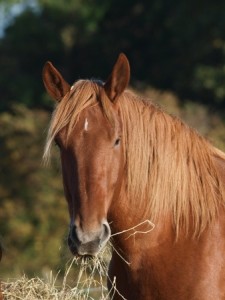
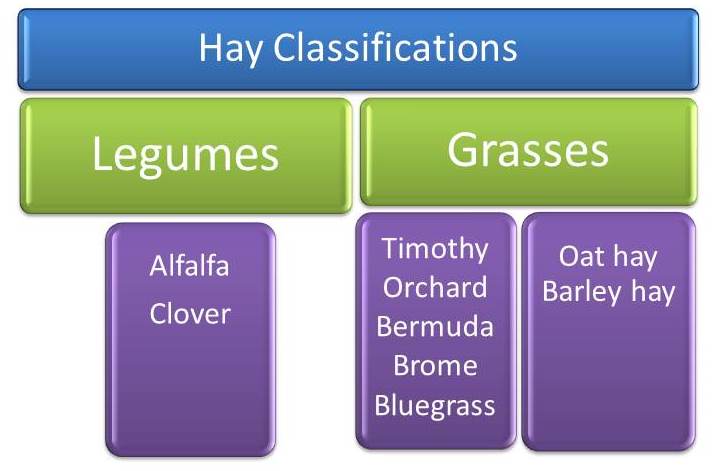
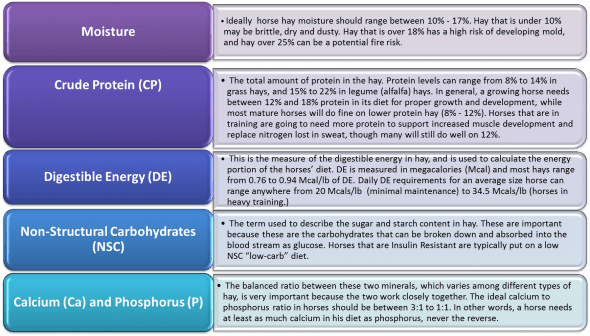
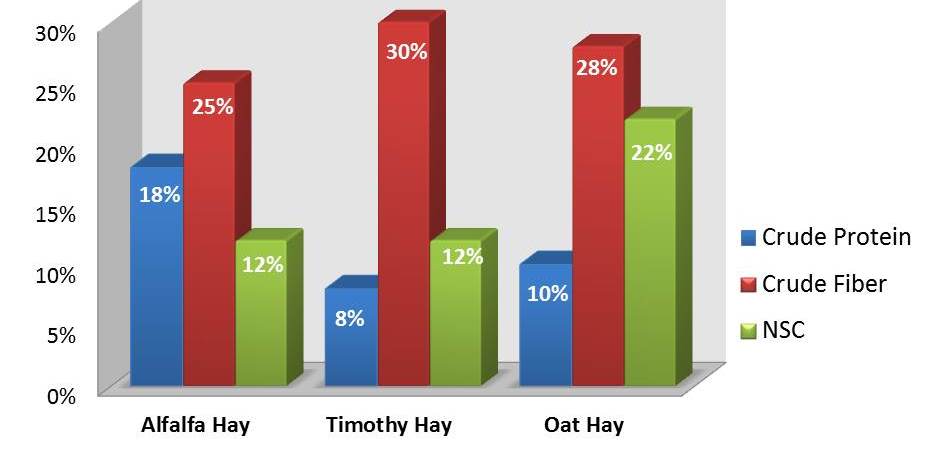
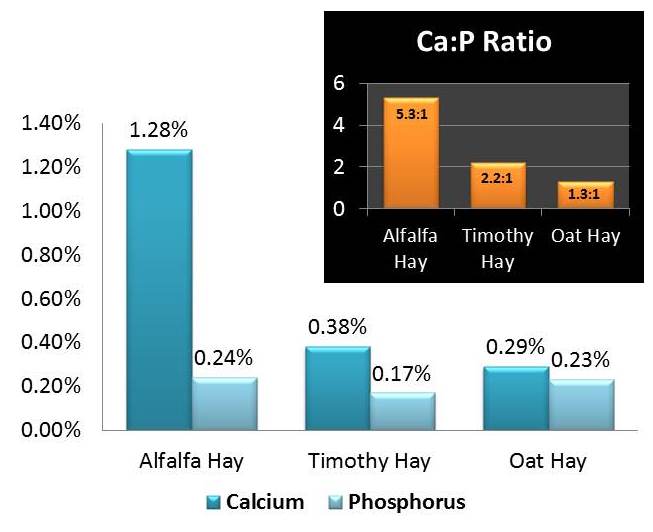




K. M. Henry says
From friend of horse owner. Owner mentioned preferring second cut. I had no clue. Hay is not “Just Hay”, like groceries is not just random “food”. I’d heard bearded grass sticks in dog paws like splinters. Hadn’t imagined it would be in deliberate animal feed OW OW OW. Justice for those who sell it or feed it….they should be made to roll in it. This article is a major education. THANKS.
Inas says
my mare is 11 years old, we do jumping since she was 4 years old.. we are now on rest as I am transforming her from shod to barefoot. Her typical diet was 6 kg of processed grain/ day (like Havens) and grass + free choice rice straw..
I want to decrease her grain intake and replace with hay, but we only have alfalfa hay in Egypt, no any other types of hay and no grass hay at all..
as she is on rest now and will be for another month.. how much should I give her from the alfalfa and how much should I take off from the grain?
Anne S. says
If her diet is good and she is not showing ribs changing her to barefoot would not require adjusting her diet.
What is important is iodized salt (2tablespoons) and a proper vitamin mineral supplement. It should have everything including selenium that is needed, but check the bag. If some are insufficient there would be signs in the horse especially the feet. Livestock mineral premix works as long as there is no rumensin which is for cattle (even machinery used not cleaned yet) which can kill a horse. So its better to find one specifically for horses unless this condition is met.
Protein is very important therefore the alfalfa is probably ideal to stick with. Go by body appearance. Sudden changes to the diet alter the gut flora which is hard on the horse also.
Mariah G says
I have a 17 year old mare who has been battling laminitis for the last 2 years. She eats straight orchard morning and night. At night she also gets Timothy pellets and assure gaurd. However, if I miss 1 day feeding her buckets she poops straight water. Had her fecal tested and it came back negative. We are located in so cal. Do you have any other suggestions on what I could feed her to help this poor mare out?
Chris says
Have you tested her for cushings?
Kim says
Is your mare eating her hay on sandy ground? My gelding had extremely watery stools that became more frequent over the course of two weeks. I tried changing his hay, his grain, taking him off grain, etc. After I had exhausted all possibilities within my scope of knowledge, the vet came out and performed a rectal exam. Diagnosis: sand colic from eating hay on the sandy, crushed granite ground here in Colorado.
Christine says
Watery stools and ongoing laminitis could point to Cushings. My gelding has much improved since tested, confirmed and now on daily meds ( which I hide successfully in a little piece of carrot).
Mari Ann says
My horses can’t eat orchard grass. Gives them the runs.
janelle lanning says
Is she on a pro/pre biotic and enzymes. My mare had a similar issue but was coming off a sever impaction colic, and then I gave her probiotic the change was overnight, she felt so much better and her scare tissue and digestion healed up.
Cheryl says
Is she on a good pre/probiotic?y experience is this helps the hindgut biome.
Karen Price says
What about fescue hay. Is there a analysis for fescue? This is often cut and used for hay in the south.
Thank you.
A Sims says
Anyone have experience with canary grass hay? nutrition value etc:
Colleen M says
Yes, it is excellent hay for horses when cut at the perfect time.. (I am not a hay dealer, so I don’t know when that perfect time is.. I just know this part of the fact of it).. canary grass, is basically the only local hay where I live.
NancyB says
I have been searching and researching but can’t come up with an answer: What is the difference between Orchard grass hay and just ‘grass hay?’ I am particularly concerned about potassium and sugar content…as my horse is supposed to have his potassium intake below 1%-2% and another in my barn has Cushings
VICKI says
I would assume “grass hay” is a generic term, as all hay has a type. Find out from the supplier which type of grass hay they are selling.
Cheri Astrahan says
You are so correct about Metabolic syndrome and laminitis. My young horse was only 7 and he was on alfalfa and we caught the laminitis early. I slowly switched him over from alfalfa to Orchard hay over two weeks so as not to cause colic. I had to soak all his hay for 3 months to lower the sugar content. He is a big horse at 17 hands and weighed about 1400 pounds (he’s the biggest quarter horse I’ve ever seen). We gave him a year off and we had him on a strict diet of Orchard and supplements approved by the vet, including the magnesium/chromium powered. We gave him a year to grow out his hooves. 3 years later his hooves are perfect, he’s down to 1200 pounds and the vet. said to keep him lean. He’s healthy and has been spent two years being conditioned and retrained after the 16 months off. He’s my sweet 1200 lb Labrador retriever. Yes, he has been taught to retrieve.
Joanne Hodeen says
How did you retrain your horse after founder? I am in my 10th month now. Horse is sound and iff meds for last month. Not sure how to go about starting him back in work. Hoof walls should all be down in a couple more months.
Thanks for your help.
Joanne Hodeen
[email protected]
Messenger
shari says
My horse is exactly the same except he doesn’t retrieve and doesn’t have laminitis!
Cassandra says
Does anyone know the crude protein of Alfalfa sprouts?
Mandi says
You may check into the accuracy of saying alfalfa hay is high in sugars and starch. It isn’t a high sugar hay. Many commonly fed grass Hays are MUCH higher in sugars and grain hay is typically high in starches.
Amy says
I believe you are correct. It seems that the opening narrative on alfalfa states one thing, however, if one were to ‘read’ the rest of the article, they will find that alfalfa indeed falls into the average range of NSC content. Alfalfa is NOT the bad actor rumor would have us believe. In fact, alfalfa is a great NATURAL way to help neutralize/balance stomach acid and potentially give some relief to horses prone to ulcers. Thanks for pointing this out.
Richard Peterson says
What is your opinion on teff hay?
Yvonne says
I use Teff for my mare that needs low sugar hay. Will probably switch all of the herd over to it as it would just be simpler. I feed a little alfalfa with it.
Janis Hagan says
Thank you for this article. It explained grass and legume hay. It also explained that blister beetles are a problem in alfalfa hay, but not bermuda grass hay.
susan Curry says
I have 2 horses & i have always fed my 1st horse alfalfa & Timothy! When we got our 2nd we put him on same diet; our 2nd horse is a piggy & eats everything!!! I am thinking about feeding him Bermuda as a grazing hay because he just eats & eats until every drop is gone!! He’s put on the needed weight; but now needs to chill out over food!! What do you think about Bermuda???
Marla weatherson says
Can i ask what does bearded wheat hay look like and why is it not good for horses?
Shawn Robinson says
Wheat stalks are called straw, they are not hay. Hay is a feed, straw is a bedding.
Justin says
The problem with bearded wheat (and also bearded barley) is that the beards can cause lesions to the horses lips and mouths. Very unpleasant.
C S says
This is a terrific article! I feel obligated to respond about the mentioned “bearded” feed, in hopes of preventing the issues caused by it: In my experience it can also create painful blockage and buildups along the trachea/digestive tract. In cattle, it’s commonly referred to as “feed lumps”, a watered down term for deadly and painful issues if not treated. Feed lumps (typically seen behind the jaw bone on the neck) are removed by literally slicing it from the outside in, pulling out what can be and left to ‘drain’.
Regardless of attempts to prevent it, my world class bull went from a loving pet to a terrified nut job in an hour’s time; he had to be put down from the experience.
I always rub my hands across my animal’s new hay to ensure nothing sticks, although sometimes either grass or alfalfa pierces my skin in small slivers 😂.
“Foxtail” is what they call the plant here, I’m surprised how prevalent it is and local cattle people don’t even bat an eye at feeding it.
Carolyn Marshall says
Do you have an analysis on Bluegrass hay? I have fed orchard grass for years but in 2018 it is almost impossible to get in Western Washington. It is all being shipped out of the country.
Barbara Oliver says
What is your opinion about rye hay as opposed to bermuda ?
Duane Bryant says
We have older horses in Mariposa Сa (about 2500’ elev) and they get alfalfa when it cools down and oat hay (complete with oat heads) when it’s warm. They eat it all, do just fine and weight stay about the same. Got one load of alfalfa they didn’t like. Strewed it on the floor and peed on it. Feed store took it back!
Doni Rasmussen says
I’ve been breeding and showing miniature horses for nearly 30 years and this was the most concise explanation I’ve seen. Thanks
Lisa says
We have some horses stocking up on our feed for this year. The feed was put up dry, early season (June in our climate is early), and appears to be a very acceptable mix of grass and legumes (timothy, meadow brome and alfalfa). I have had horses do the same on 2nd cut that is too rich. I am going to get the feed tested, but which component of the hay should I be most concerned with (Energy vs. Protein)?
Jacqueline Wood says
Thank you!! Great article answered vital questions I had about the various hay types.
Avi de Turenne says
Great article!
Cynthia says
Great article with relevant statistics.
Dennis Lockhart says
When I buy hay, sometimes they tell me it’s first cut or second cut. What is the best cut hay to buy?
Paige says
Second cut is better
First means that they cut the hay before winter and second means that they cut the hay in the summer
Karen says
First cut in western Pennsylvania is usually between middle to late May and beginning of July. Second cut is July to August and sometimes get a third cut in August to September.
First cut if it still has the wonderful seed heads is most nutritious. But second cut is “softer” and the older horses can chew it easier.
Janet says
That sounds weird to me. First cut is first cut of the hay harvesting season and second cut is the second time cutting the hay that regrew after the first cutting. Second cut or as we call it here in Wisconsin “second crop” is usually finer and more nutrient dense. Hope that helps.
Justin says
Many grass species only produce seed heads once a year during spring growth. This will be captured in a first cut hay. So first cut hay will generally be more stemmy and less nutrient dense than a second or third or even a fourth if the good lord provides the weather. The regrowth is generally more leafy. Something to watch out for is that a second or third cutting can have much higher NSC if the grass was stressed by heat and drought.
Norma Frost says
Thank you! Just the information I was looking for my obese Halflinger!
Brasseur Sophie says
Française, et pour nous aussi c’ est un article excellent, merci beaucoup à vous.
Debra says
Excellent information Thank you!
smrabalais67 says
Great info. Thanks
Renate Miller says
Very good article, written very well!
Ginny Vitera says
This is one of the best articles I’ve read about hay. Thank you.
Liz Neuman says
Thank you – I’m glad you enjoyed it!
Lisa says
excellent information. Thank you so much!